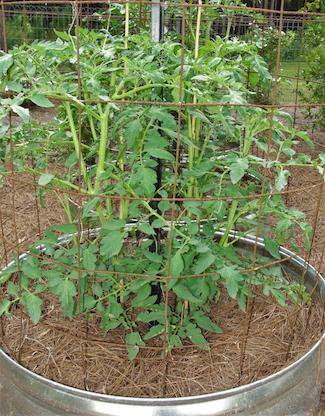
Tomatoes in East Texas are best planted between mid-March and early April.
March 15, 2023 - I’m embarrassed to admit that I’m not a rabid tomato eater. Sure, I eat them on hamburgers and in spaghetti sauce but with the exception of Romas for making homemade Aggie hot sauce, I rarely purchase them at the grocery store. The biggest reason is that those from the grocery store are barely edible! The only time of the year that I eat fresh tomatoes is when I grow them in the garden. And I grow plenty of them. Although I’m not a tomato lover, I come from a family who is in love with tomatoes. It’s always been my job to keep the relationship healthy. I’m happy eating easy-to-grow cherry, plum, and other small, fruited tomatoes, but my family wants big slicing types.
Tomatoes are planted from transplants after all danger of frost in the spring (no later than April). They cannot tolerate frosts or freezes and thrive with mild and moderately warm temperatures in spring and early summer. Tomatoes do not set fruit in the heat of Texas summers (above 92 degrees), which leaves only a small window of opportunity in the spring to form fruit. This makes planting time very critical. If you plant too soon, frost will kill them. However, if you plant too late, you severely reduce your production. Therefore, as soon as the last frost occurs in your area, plan on getting your tomato transplants in the ground. The ideal transplant is 6 to 8 inches tall, dark green, and has six to eight healthy leaves. Avoid those that are yellow-green, purple-green, or tough and woody. These are stunted and will not produce a bountiful harvest. To avoid unexpected late frosts, many Texas gardeners have buckets, hot caps, or row cover ready for protecting their plants. Generally summer heat and drought kill spring-planted tomatoes in Texas.
Tomatoes require at least eight hours of direct sun each day for maximum yields. If you can’t sunbathe there, you can’t grow tomatoes, or many other vegetables for that matter. Tomatoes do best in rich, loamy soils. Due to a problem with root-infecting microscopic nematodes, it is best to avoid areas where this has been a problem or where tomatoes have grown the previous year. Ideally, till in several inches of compost or organic matter and incorporate 2 pounds of a complete lawn fertilizer (15-5-10, 18-6-12, and so forth) per 100 square feet of bed or every 35 feet of row before planting. In small plantings incorporate 2 teaspoons per square foot or foot of row. Many rabid tomato growers add a little extra something below the planting hole, including animal manures, cottonseed meal, slow-release fertilizer, and Epsom salt. The ideal soil pH for growing tomatoes is 6.0 to 7.0.
Tomato transplants should be planted in well-cultivated soil. Dig holes twice as wide and at least as deep as the existing pots the tomatoes are growing in. Tomatoes can form roots along their stem so tall plants should have the lower several inches of their stems buried beneath the soil. By planting them deeper, you produce a stronger plant with more roots. Strip any foliage off the lower stem that is to be beneath the ground and place into the hole. Gently firm the soil around them. Water thoroughly with a water-soluble plant food such as Miracle-Gro at half the labeled recommendation. Many successful organic gardeners use manure tea for this.
Tomatoes grow and set fruit only when the temperatures are warm but below 92 degrees. About three weeks after transplanting, fertilize them with 1 cup of high-nitrogen fertilizer (21-0-0, etc.) for each 35 feet of row. Sprinkle half of the fertilizer down each side of the row. Lightly work it into the soil and then water. Repeat this fertilizing process every two to three weeks to keep the plants vigorous. If you only have a few plants, use 2 to 3 teaspoons sprinkled around (but not on) each plant. Be sure to work it lightly into the soil and water the plants well afterward.
Greg Grant is the Smith County horticulturist for the Texas A&M AgriLife Extension Service. He is author of Texas Fruit and Vegetable Gardening, Heirloom Gardening in the South, and the Rose Rustlers. You can read his “Greg’s Ramblings” blog at arborgate.com, read his “In Greg’s Garden” in each issue of Texas Gardener magazine (texasgardener.com), and follow him on Facebook at “Greg Grant Gardens.” More science-based lawn and gardening information from the Texas A&M AgriLife Extension Service can be found at aggieturf.tamu.edu and aggie-horticulture.tamu.edu.








